Strategic Performance Management System Research and Analysis Report
VerifiedAdded on 2019/11/20
|19
|5311
|227
Report
AI Summary
This report provides a comprehensive analysis of Strategic Performance Management Systems (SPMS), exploring its various aspects through a literature review and case studies of AGL Energy Ltd and Bank of Queensland. The research delves into multi-perspective SPMS, highlighting its objectives, elements, and the SPMS process, including planning, monitoring, evaluation, and rewarding. It examines motivation theories, particularly Maslow's hierarchy of needs, and their application in the workplace, linking them to reward systems to improve employee performance. The report discusses the strengths and drawbacks of SPMS, its evolution, and its integration with the balanced scorecard. The analysis covers the efficiency of SPMS in public and private sectors, emphasizing its role in enhancing productivity, financial performance, and employee satisfaction. The report also examines the use of extrinsic and intrinsic rewards to motivate employees, offering insights into how organizations can optimize their reward systems to drive better performance. This report is designed to provide a comprehensive overview of SPMS and its significance in modern business practices.
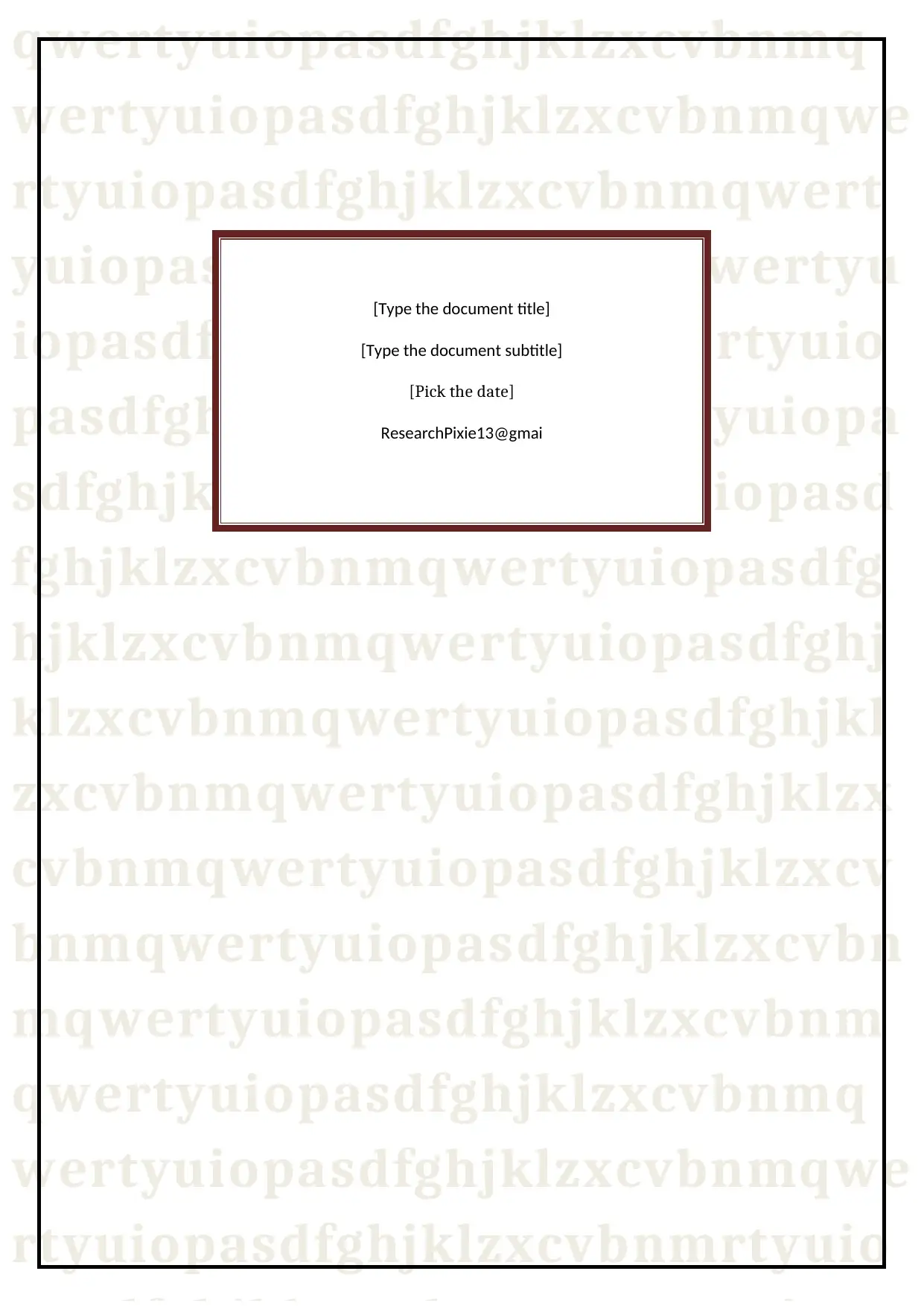
qwertyuiopasdfghjklzxcvbnmq
wertyuiopasdfghjklzxcvbnmqwe
rtyuiopasdfghjklzxcvbnmqwert
yuiopasdfghjklzxcvbnmqwertyu
iopasdfghjklzxcvbnmqwertyuio
pasdfghjklzxcvbnmqwertyuiopa
sdfghjklzxcvbnmqwertyuiopasd
fghjklzxcvbnmqwertyuiopasdfg
hjklzxcvbnmqwertyuiopasdfghj
klzxcvbnmqwertyuiopasdfghjkl
zxcvbnmqwertyuiopasdfghjklzx
cvbnmqwertyuiopasdfghjklzxcv
bnmqwertyuiopasdfghjklzxcvbn
mqwertyuiopasdfghjklzxcvbnm
qwertyuiopasdfghjklzxcvbnmq
wertyuiopasdfghjklzxcvbnmqwe
rtyuiopasdfghjklzxcvbnmrtyuio
[Type the document title]
[Type the document subtitle]
[Pick the date]
ResearchPixie13@gmai
wertyuiopasdfghjklzxcvbnmqwe
rtyuiopasdfghjklzxcvbnmqwert
yuiopasdfghjklzxcvbnmqwertyu
iopasdfghjklzxcvbnmqwertyuio
pasdfghjklzxcvbnmqwertyuiopa
sdfghjklzxcvbnmqwertyuiopasd
fghjklzxcvbnmqwertyuiopasdfg
hjklzxcvbnmqwertyuiopasdfghj
klzxcvbnmqwertyuiopasdfghjkl
zxcvbnmqwertyuiopasdfghjklzx
cvbnmqwertyuiopasdfghjklzxcv
bnmqwertyuiopasdfghjklzxcvbn
mqwertyuiopasdfghjklzxcvbnm
qwertyuiopasdfghjklzxcvbnmq
wertyuiopasdfghjklzxcvbnmqwe
rtyuiopasdfghjklzxcvbnmrtyuio
[Type the document title]
[Type the document subtitle]
[Pick the date]
ResearchPixie13@gmai
Paraphrase This Document
Need a fresh take? Get an instant paraphrase of this document with our AI Paraphraser
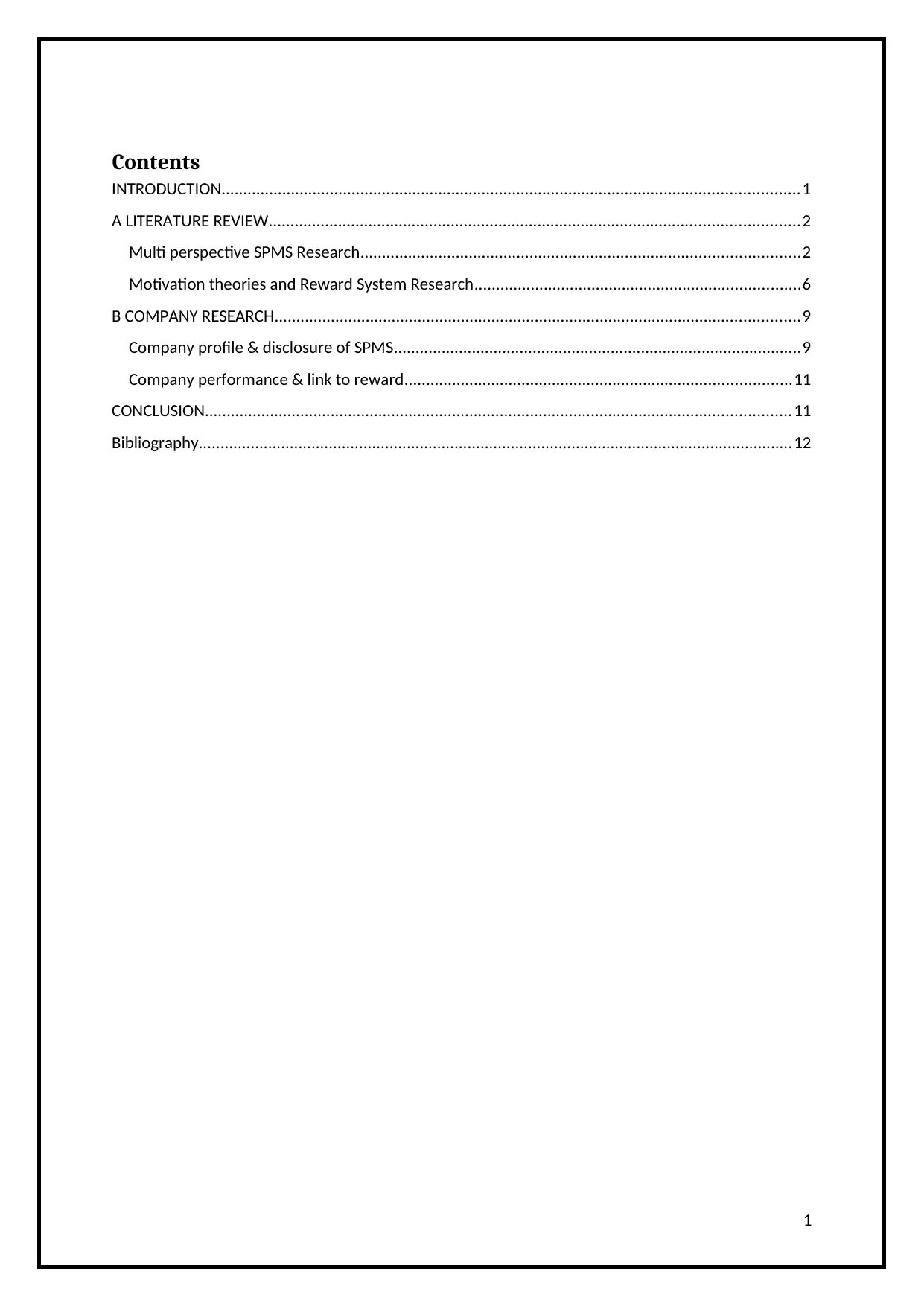
Contents
INTRODUCTION.....................................................................................................................................1
A LITERATURE REVIEW..........................................................................................................................2
Multi perspective SPMS Research.....................................................................................................2
Motivation theories and Reward System Research...........................................................................6
B COMPANY RESEARCH.........................................................................................................................9
Company profile & disclosure of SPMS..............................................................................................9
Company performance & link to reward.........................................................................................11
CONCLUSION.......................................................................................................................................11
Bibliography.........................................................................................................................................12
1
INTRODUCTION.....................................................................................................................................1
A LITERATURE REVIEW..........................................................................................................................2
Multi perspective SPMS Research.....................................................................................................2
Motivation theories and Reward System Research...........................................................................6
B COMPANY RESEARCH.........................................................................................................................9
Company profile & disclosure of SPMS..............................................................................................9
Company performance & link to reward.........................................................................................11
CONCLUSION.......................................................................................................................................11
Bibliography.........................................................................................................................................12
1
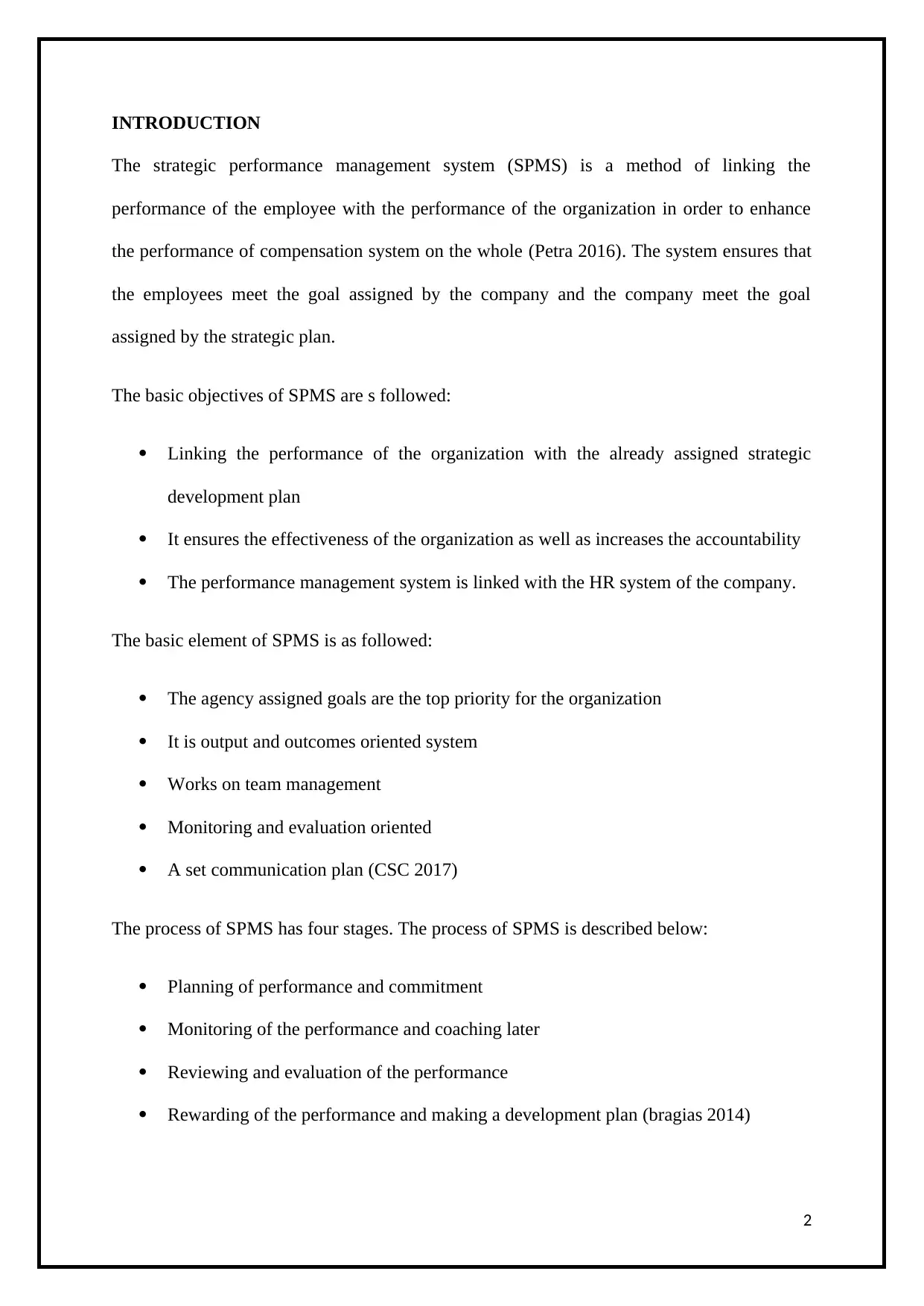
INTRODUCTION
The strategic performance management system (SPMS) is a method of linking the
performance of the employee with the performance of the organization in order to enhance
the performance of compensation system on the whole (Petra 2016). The system ensures that
the employees meet the goal assigned by the company and the company meet the goal
assigned by the strategic plan.
The basic objectives of SPMS are s followed:
Linking the performance of the organization with the already assigned strategic
development plan
It ensures the effectiveness of the organization as well as increases the accountability
The performance management system is linked with the HR system of the company.
The basic element of SPMS is as followed:
The agency assigned goals are the top priority for the organization
It is output and outcomes oriented system
Works on team management
Monitoring and evaluation oriented
A set communication plan (CSC 2017)
The process of SPMS has four stages. The process of SPMS is described below:
Planning of performance and commitment
Monitoring of the performance and coaching later
Reviewing and evaluation of the performance
Rewarding of the performance and making a development plan (bragias 2014)
2
The strategic performance management system (SPMS) is a method of linking the
performance of the employee with the performance of the organization in order to enhance
the performance of compensation system on the whole (Petra 2016). The system ensures that
the employees meet the goal assigned by the company and the company meet the goal
assigned by the strategic plan.
The basic objectives of SPMS are s followed:
Linking the performance of the organization with the already assigned strategic
development plan
It ensures the effectiveness of the organization as well as increases the accountability
The performance management system is linked with the HR system of the company.
The basic element of SPMS is as followed:
The agency assigned goals are the top priority for the organization
It is output and outcomes oriented system
Works on team management
Monitoring and evaluation oriented
A set communication plan (CSC 2017)
The process of SPMS has four stages. The process of SPMS is described below:
Planning of performance and commitment
Monitoring of the performance and coaching later
Reviewing and evaluation of the performance
Rewarding of the performance and making a development plan (bragias 2014)
2
⊘ This is a preview!⊘
Do you want full access?
Subscribe today to unlock all pages.

Trusted by 1+ million students worldwide
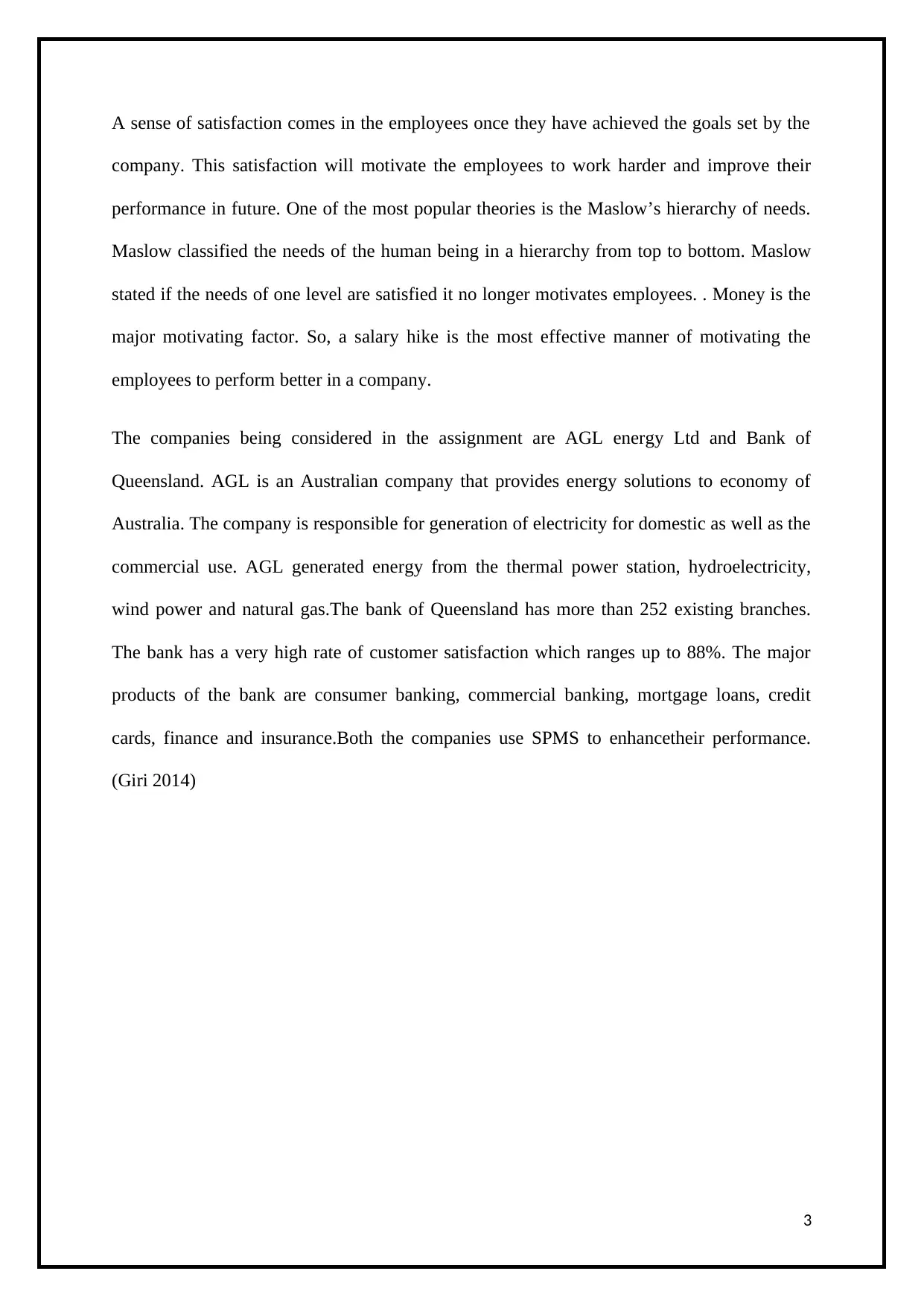
A sense of satisfaction comes in the employees once they have achieved the goals set by the
company. This satisfaction will motivate the employees to work harder and improve their
performance in future. One of the most popular theories is the Maslow’s hierarchy of needs.
Maslow classified the needs of the human being in a hierarchy from top to bottom. Maslow
stated if the needs of one level are satisfied it no longer motivates employees. . Money is the
major motivating factor. So, a salary hike is the most effective manner of motivating the
employees to perform better in a company.
The companies being considered in the assignment are AGL energy Ltd and Bank of
Queensland. AGL is an Australian company that provides energy solutions to economy of
Australia. The company is responsible for generation of electricity for domestic as well as the
commercial use. AGL generated energy from the thermal power station, hydroelectricity,
wind power and natural gas.The bank of Queensland has more than 252 existing branches.
The bank has a very high rate of customer satisfaction which ranges up to 88%. The major
products of the bank are consumer banking, commercial banking, mortgage loans, credit
cards, finance and insurance.Both the companies use SPMS to enhancetheir performance.
(Giri 2014)
3
company. This satisfaction will motivate the employees to work harder and improve their
performance in future. One of the most popular theories is the Maslow’s hierarchy of needs.
Maslow classified the needs of the human being in a hierarchy from top to bottom. Maslow
stated if the needs of one level are satisfied it no longer motivates employees. . Money is the
major motivating factor. So, a salary hike is the most effective manner of motivating the
employees to perform better in a company.
The companies being considered in the assignment are AGL energy Ltd and Bank of
Queensland. AGL is an Australian company that provides energy solutions to economy of
Australia. The company is responsible for generation of electricity for domestic as well as the
commercial use. AGL generated energy from the thermal power station, hydroelectricity,
wind power and natural gas.The bank of Queensland has more than 252 existing branches.
The bank has a very high rate of customer satisfaction which ranges up to 88%. The major
products of the bank are consumer banking, commercial banking, mortgage loans, credit
cards, finance and insurance.Both the companies use SPMS to enhancetheir performance.
(Giri 2014)
3
Paraphrase This Document
Need a fresh take? Get an instant paraphrase of this document with our AI Paraphraser
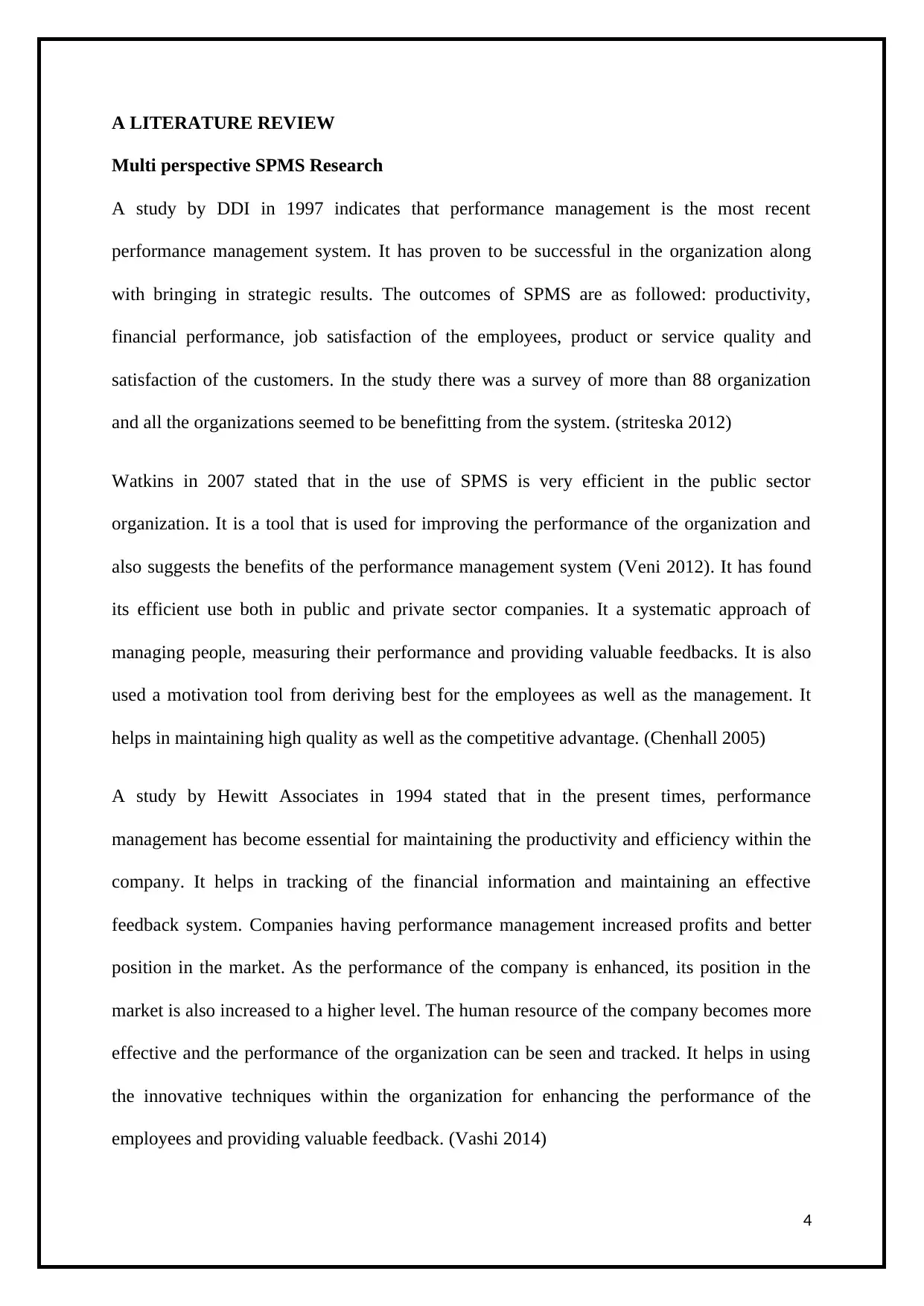
A LITERATURE REVIEW
Multi perspective SPMS Research
A study by DDI in 1997 indicates that performance management is the most recent
performance management system. It has proven to be successful in the organization along
with bringing in strategic results. The outcomes of SPMS are as followed: productivity,
financial performance, job satisfaction of the employees, product or service quality and
satisfaction of the customers. In the study there was a survey of more than 88 organization
and all the organizations seemed to be benefitting from the system. (striteska 2012)
Watkins in 2007 stated that in the use of SPMS is very efficient in the public sector
organization. It is a tool that is used for improving the performance of the organization and
also suggests the benefits of the performance management system (Veni 2012). It has found
its efficient use both in public and private sector companies. It a systematic approach of
managing people, measuring their performance and providing valuable feedbacks. It is also
used a motivation tool from deriving best for the employees as well as the management. It
helps in maintaining high quality as well as the competitive advantage. (Chenhall 2005)
A study by Hewitt Associates in 1994 stated that in the present times, performance
management has become essential for maintaining the productivity and efficiency within the
company. It helps in tracking of the financial information and maintaining an effective
feedback system. Companies having performance management increased profits and better
position in the market. As the performance of the company is enhanced, its position in the
market is also increased to a higher level. The human resource of the company becomes more
effective and the performance of the organization can be seen and tracked. It helps in using
the innovative techniques within the organization for enhancing the performance of the
employees and providing valuable feedback. (Vashi 2014)
4
Multi perspective SPMS Research
A study by DDI in 1997 indicates that performance management is the most recent
performance management system. It has proven to be successful in the organization along
with bringing in strategic results. The outcomes of SPMS are as followed: productivity,
financial performance, job satisfaction of the employees, product or service quality and
satisfaction of the customers. In the study there was a survey of more than 88 organization
and all the organizations seemed to be benefitting from the system. (striteska 2012)
Watkins in 2007 stated that in the use of SPMS is very efficient in the public sector
organization. It is a tool that is used for improving the performance of the organization and
also suggests the benefits of the performance management system (Veni 2012). It has found
its efficient use both in public and private sector companies. It a systematic approach of
managing people, measuring their performance and providing valuable feedbacks. It is also
used a motivation tool from deriving best for the employees as well as the management. It
helps in maintaining high quality as well as the competitive advantage. (Chenhall 2005)
A study by Hewitt Associates in 1994 stated that in the present times, performance
management has become essential for maintaining the productivity and efficiency within the
company. It helps in tracking of the financial information and maintaining an effective
feedback system. Companies having performance management increased profits and better
position in the market. As the performance of the company is enhanced, its position in the
market is also increased to a higher level. The human resource of the company becomes more
effective and the performance of the organization can be seen and tracked. It helps in using
the innovative techniques within the organization for enhancing the performance of the
employees and providing valuable feedback. (Vashi 2014)
4
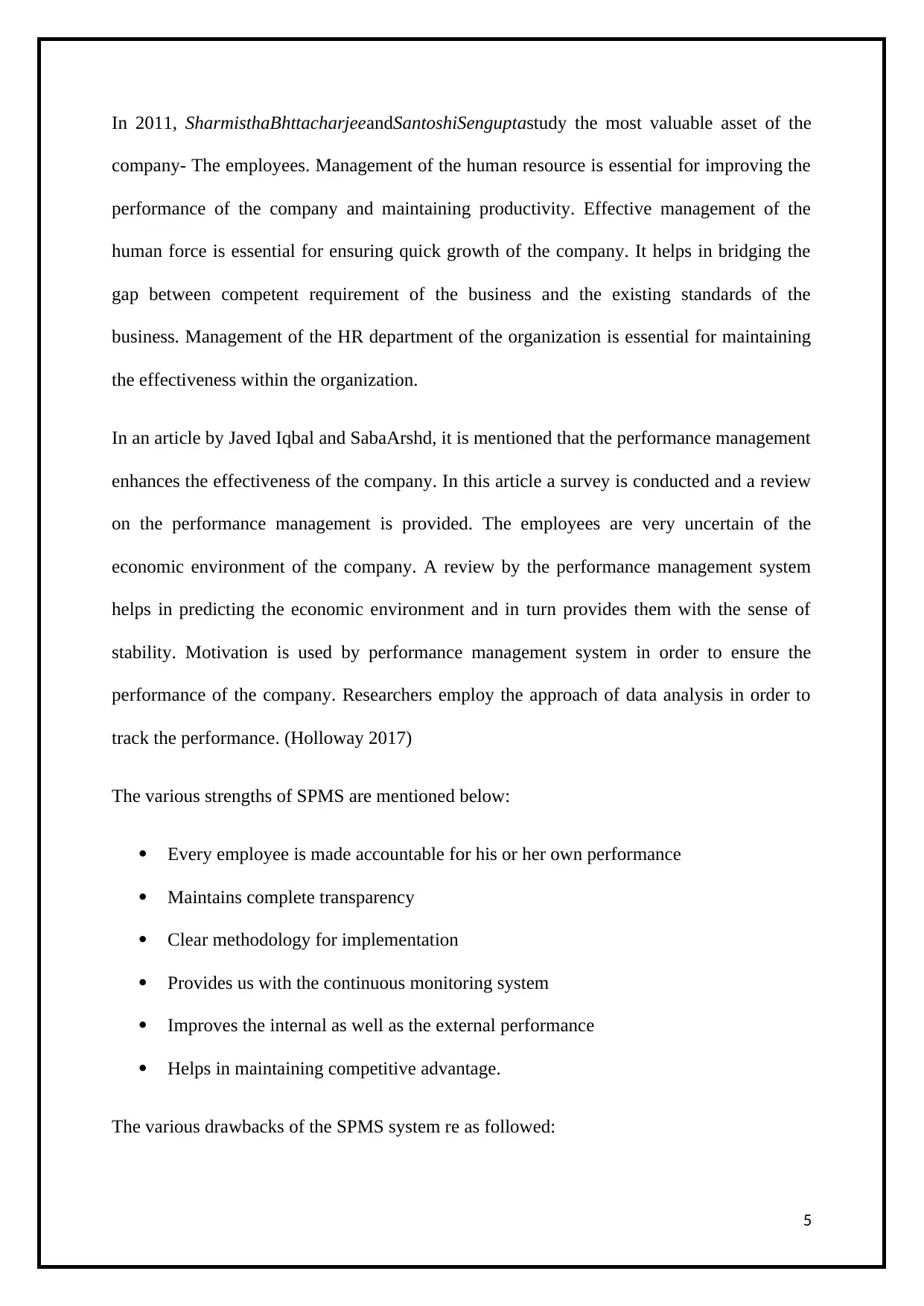
In 2011, SharmisthaBhttacharjeeandSantoshiSenguptastudy the most valuable asset of the
company- The employees. Management of the human resource is essential for improving the
performance of the company and maintaining productivity. Effective management of the
human force is essential for ensuring quick growth of the company. It helps in bridging the
gap between competent requirement of the business and the existing standards of the
business. Management of the HR department of the organization is essential for maintaining
the effectiveness within the organization.
In an article by Javed Iqbal and SabaArshd, it is mentioned that the performance management
enhances the effectiveness of the company. In this article a survey is conducted and a review
on the performance management is provided. The employees are very uncertain of the
economic environment of the company. A review by the performance management system
helps in predicting the economic environment and in turn provides them with the sense of
stability. Motivation is used by performance management system in order to ensure the
performance of the company. Researchers employ the approach of data analysis in order to
track the performance. (Holloway 2017)
The various strengths of SPMS are mentioned below:
Every employee is made accountable for his or her own performance
Maintains complete transparency
Clear methodology for implementation
Provides us with the continuous monitoring system
Improves the internal as well as the external performance
Helps in maintaining competitive advantage.
The various drawbacks of the SPMS system re as followed:
5
company- The employees. Management of the human resource is essential for improving the
performance of the company and maintaining productivity. Effective management of the
human force is essential for ensuring quick growth of the company. It helps in bridging the
gap between competent requirement of the business and the existing standards of the
business. Management of the HR department of the organization is essential for maintaining
the effectiveness within the organization.
In an article by Javed Iqbal and SabaArshd, it is mentioned that the performance management
enhances the effectiveness of the company. In this article a survey is conducted and a review
on the performance management is provided. The employees are very uncertain of the
economic environment of the company. A review by the performance management system
helps in predicting the economic environment and in turn provides them with the sense of
stability. Motivation is used by performance management system in order to ensure the
performance of the company. Researchers employ the approach of data analysis in order to
track the performance. (Holloway 2017)
The various strengths of SPMS are mentioned below:
Every employee is made accountable for his or her own performance
Maintains complete transparency
Clear methodology for implementation
Provides us with the continuous monitoring system
Improves the internal as well as the external performance
Helps in maintaining competitive advantage.
The various drawbacks of the SPMS system re as followed:
5
⊘ This is a preview!⊘
Do you want full access?
Subscribe today to unlock all pages.

Trusted by 1+ million students worldwide
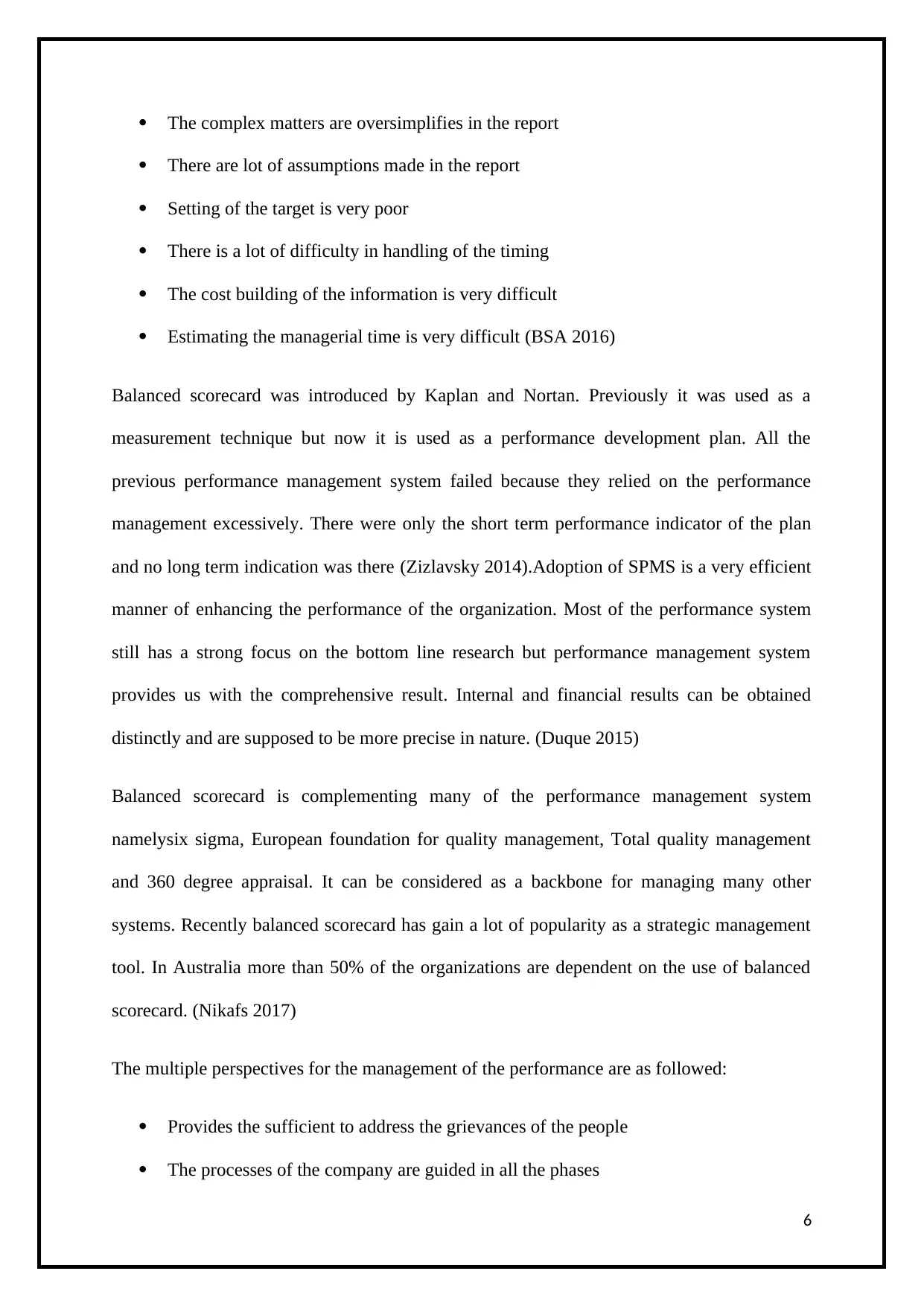
The complex matters are oversimplifies in the report
There are lot of assumptions made in the report
Setting of the target is very poor
There is a lot of difficulty in handling of the timing
The cost building of the information is very difficult
Estimating the managerial time is very difficult (BSA 2016)
Balanced scorecard was introduced by Kaplan and Nortan. Previously it was used as a
measurement technique but now it is used as a performance development plan. All the
previous performance management system failed because they relied on the performance
management excessively. There were only the short term performance indicator of the plan
and no long term indication was there (Zizlavsky 2014).Adoption of SPMS is a very efficient
manner of enhancing the performance of the organization. Most of the performance system
still has a strong focus on the bottom line research but performance management system
provides us with the comprehensive result. Internal and financial results can be obtained
distinctly and are supposed to be more precise in nature. (Duque 2015)
Balanced scorecard is complementing many of the performance management system
namelysix sigma, European foundation for quality management, Total quality management
and 360 degree appraisal. It can be considered as a backbone for managing many other
systems. Recently balanced scorecard has gain a lot of popularity as a strategic management
tool. In Australia more than 50% of the organizations are dependent on the use of balanced
scorecard. (Nikafs 2017)
The multiple perspectives for the management of the performance are as followed:
Provides the sufficient to address the grievances of the people
The processes of the company are guided in all the phases
6
There are lot of assumptions made in the report
Setting of the target is very poor
There is a lot of difficulty in handling of the timing
The cost building of the information is very difficult
Estimating the managerial time is very difficult (BSA 2016)
Balanced scorecard was introduced by Kaplan and Nortan. Previously it was used as a
measurement technique but now it is used as a performance development plan. All the
previous performance management system failed because they relied on the performance
management excessively. There were only the short term performance indicator of the plan
and no long term indication was there (Zizlavsky 2014).Adoption of SPMS is a very efficient
manner of enhancing the performance of the organization. Most of the performance system
still has a strong focus on the bottom line research but performance management system
provides us with the comprehensive result. Internal and financial results can be obtained
distinctly and are supposed to be more precise in nature. (Duque 2015)
Balanced scorecard is complementing many of the performance management system
namelysix sigma, European foundation for quality management, Total quality management
and 360 degree appraisal. It can be considered as a backbone for managing many other
systems. Recently balanced scorecard has gain a lot of popularity as a strategic management
tool. In Australia more than 50% of the organizations are dependent on the use of balanced
scorecard. (Nikafs 2017)
The multiple perspectives for the management of the performance are as followed:
Provides the sufficient to address the grievances of the people
The processes of the company are guided in all the phases
6
Paraphrase This Document
Need a fresh take? Get an instant paraphrase of this document with our AI Paraphraser
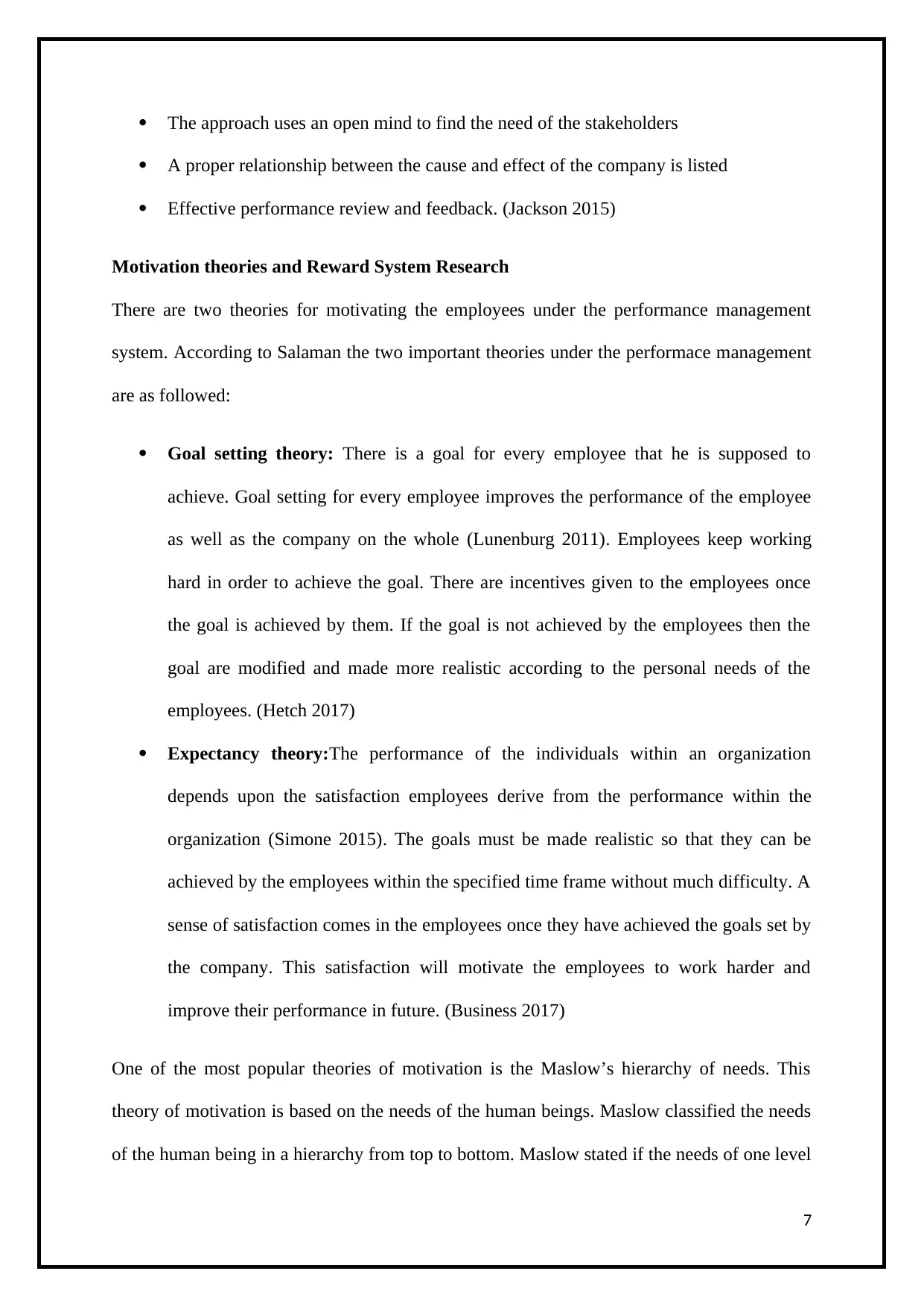
The approach uses an open mind to find the need of the stakeholders
A proper relationship between the cause and effect of the company is listed
Effective performance review and feedback. (Jackson 2015)
Motivation theories and Reward System Research
There are two theories for motivating the employees under the performance management
system. According to Salaman the two important theories under the performace management
are as followed:
Goal setting theory: There is a goal for every employee that he is supposed to
achieve. Goal setting for every employee improves the performance of the employee
as well as the company on the whole (Lunenburg 2011). Employees keep working
hard in order to achieve the goal. There are incentives given to the employees once
the goal is achieved by them. If the goal is not achieved by the employees then the
goal are modified and made more realistic according to the personal needs of the
employees. (Hetch 2017)
Expectancy theory:The performance of the individuals within an organization
depends upon the satisfaction employees derive from the performance within the
organization (Simone 2015). The goals must be made realistic so that they can be
achieved by the employees within the specified time frame without much difficulty. A
sense of satisfaction comes in the employees once they have achieved the goals set by
the company. This satisfaction will motivate the employees to work harder and
improve their performance in future. (Business 2017)
One of the most popular theories of motivation is the Maslow’s hierarchy of needs. This
theory of motivation is based on the needs of the human beings. Maslow classified the needs
of the human being in a hierarchy from top to bottom. Maslow stated if the needs of one level
7
A proper relationship between the cause and effect of the company is listed
Effective performance review and feedback. (Jackson 2015)
Motivation theories and Reward System Research
There are two theories for motivating the employees under the performance management
system. According to Salaman the two important theories under the performace management
are as followed:
Goal setting theory: There is a goal for every employee that he is supposed to
achieve. Goal setting for every employee improves the performance of the employee
as well as the company on the whole (Lunenburg 2011). Employees keep working
hard in order to achieve the goal. There are incentives given to the employees once
the goal is achieved by them. If the goal is not achieved by the employees then the
goal are modified and made more realistic according to the personal needs of the
employees. (Hetch 2017)
Expectancy theory:The performance of the individuals within an organization
depends upon the satisfaction employees derive from the performance within the
organization (Simone 2015). The goals must be made realistic so that they can be
achieved by the employees within the specified time frame without much difficulty. A
sense of satisfaction comes in the employees once they have achieved the goals set by
the company. This satisfaction will motivate the employees to work harder and
improve their performance in future. (Business 2017)
One of the most popular theories of motivation is the Maslow’s hierarchy of needs. This
theory of motivation is based on the needs of the human beings. Maslow classified the needs
of the human being in a hierarchy from top to bottom. Maslow stated if the needs of one level
7
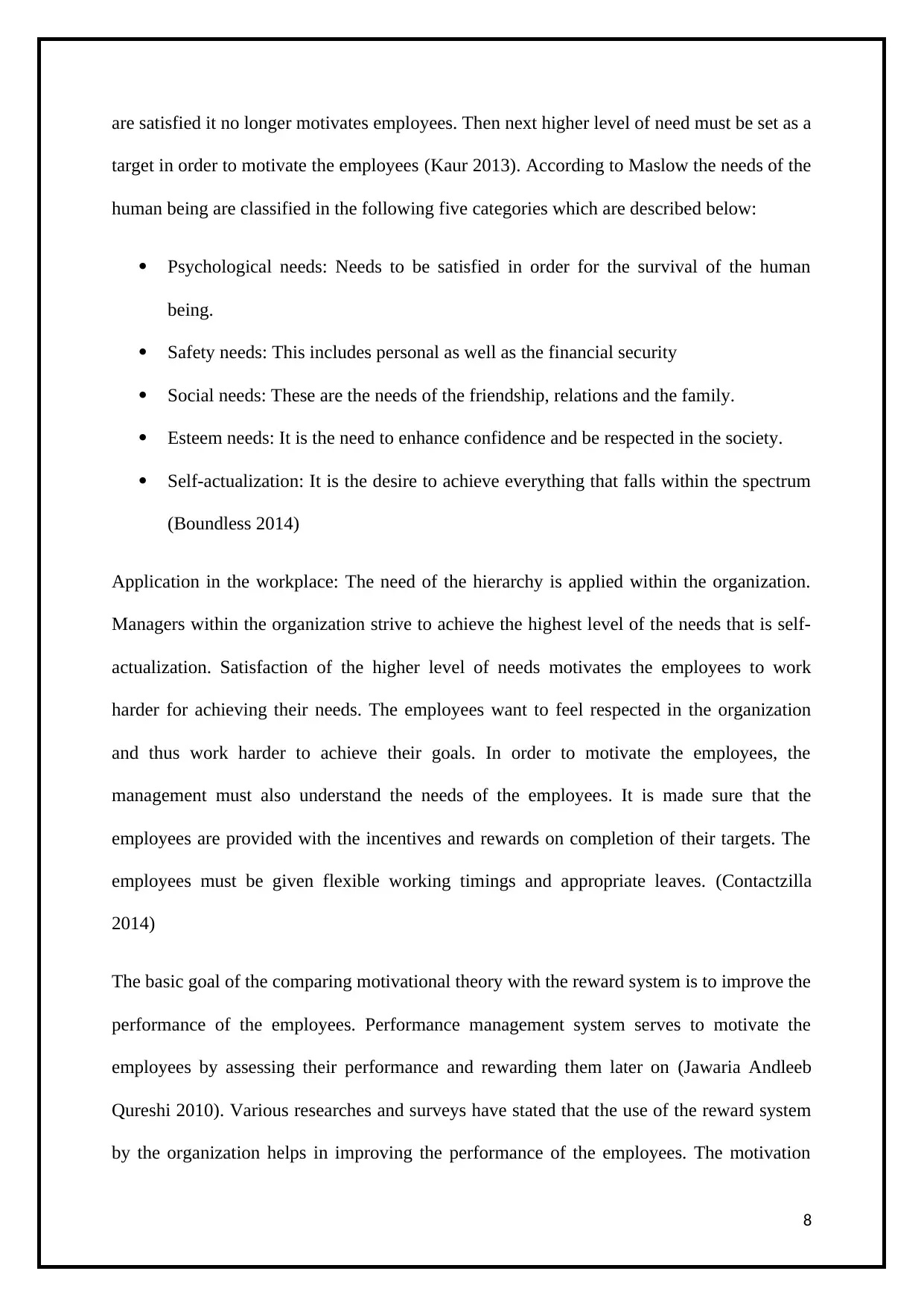
are satisfied it no longer motivates employees. Then next higher level of need must be set as a
target in order to motivate the employees (Kaur 2013). According to Maslow the needs of the
human being are classified in the following five categories which are described below:
Psychological needs: Needs to be satisfied in order for the survival of the human
being.
Safety needs: This includes personal as well as the financial security
Social needs: These are the needs of the friendship, relations and the family.
Esteem needs: It is the need to enhance confidence and be respected in the society.
Self-actualization: It is the desire to achieve everything that falls within the spectrum
(Boundless 2014)
Application in the workplace: The need of the hierarchy is applied within the organization.
Managers within the organization strive to achieve the highest level of the needs that is self-
actualization. Satisfaction of the higher level of needs motivates the employees to work
harder for achieving their needs. The employees want to feel respected in the organization
and thus work harder to achieve their goals. In order to motivate the employees, the
management must also understand the needs of the employees. It is made sure that the
employees are provided with the incentives and rewards on completion of their targets. The
employees must be given flexible working timings and appropriate leaves. (Contactzilla
2014)
The basic goal of the comparing motivational theory with the reward system is to improve the
performance of the employees. Performance management system serves to motivate the
employees by assessing their performance and rewarding them later on (Jawaria Andleeb
Qureshi 2010). Various researches and surveys have stated that the use of the reward system
by the organization helps in improving the performance of the employees. The motivation
8
target in order to motivate the employees (Kaur 2013). According to Maslow the needs of the
human being are classified in the following five categories which are described below:
Psychological needs: Needs to be satisfied in order for the survival of the human
being.
Safety needs: This includes personal as well as the financial security
Social needs: These are the needs of the friendship, relations and the family.
Esteem needs: It is the need to enhance confidence and be respected in the society.
Self-actualization: It is the desire to achieve everything that falls within the spectrum
(Boundless 2014)
Application in the workplace: The need of the hierarchy is applied within the organization.
Managers within the organization strive to achieve the highest level of the needs that is self-
actualization. Satisfaction of the higher level of needs motivates the employees to work
harder for achieving their needs. The employees want to feel respected in the organization
and thus work harder to achieve their goals. In order to motivate the employees, the
management must also understand the needs of the employees. It is made sure that the
employees are provided with the incentives and rewards on completion of their targets. The
employees must be given flexible working timings and appropriate leaves. (Contactzilla
2014)
The basic goal of the comparing motivational theory with the reward system is to improve the
performance of the employees. Performance management system serves to motivate the
employees by assessing their performance and rewarding them later on (Jawaria Andleeb
Qureshi 2010). Various researches and surveys have stated that the use of the reward system
by the organization helps in improving the performance of the employees. The motivation
8
⊘ This is a preview!⊘
Do you want full access?
Subscribe today to unlock all pages.

Trusted by 1+ million students worldwide
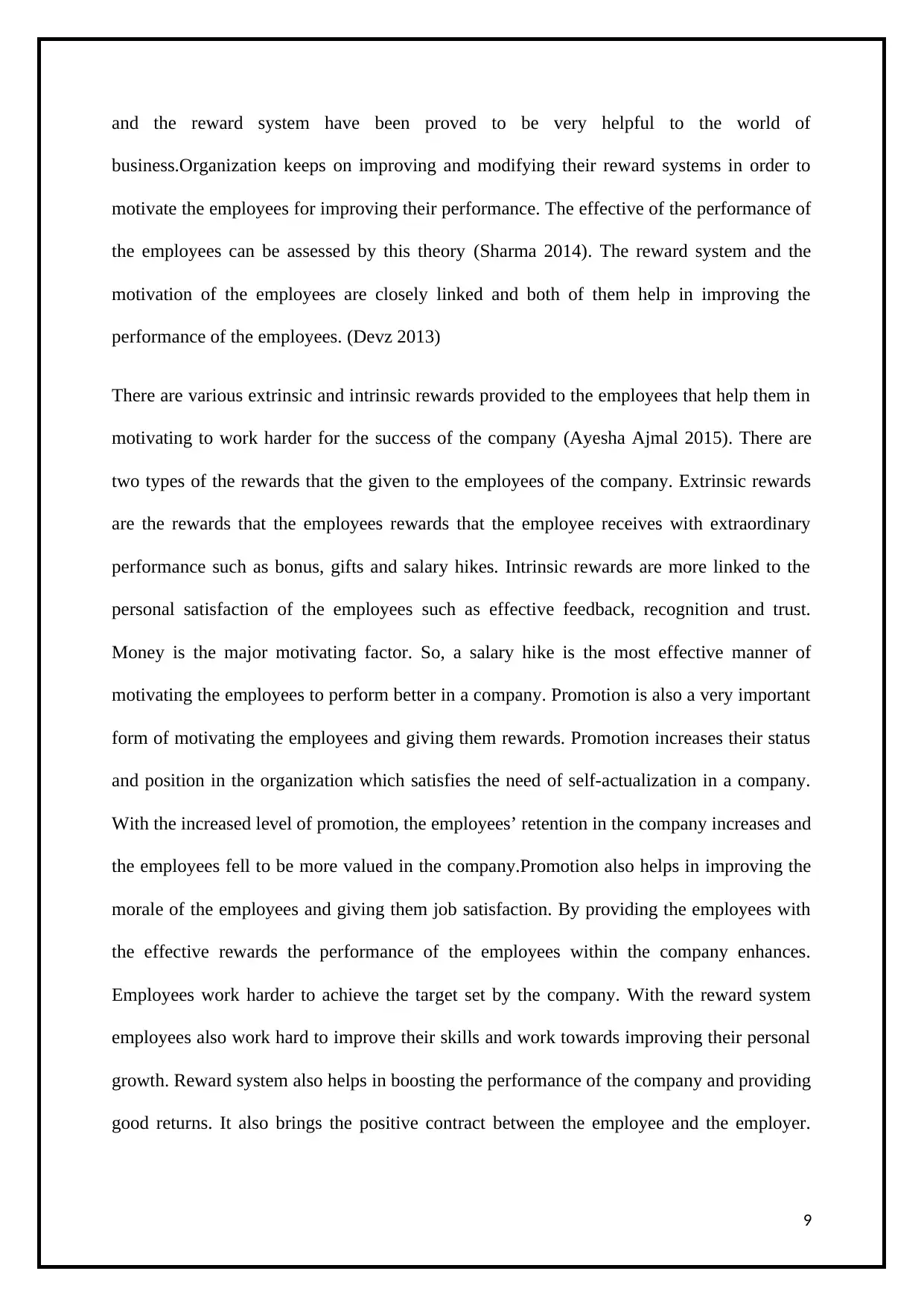
and the reward system have been proved to be very helpful to the world of
business.Organization keeps on improving and modifying their reward systems in order to
motivate the employees for improving their performance. The effective of the performance of
the employees can be assessed by this theory (Sharma 2014). The reward system and the
motivation of the employees are closely linked and both of them help in improving the
performance of the employees. (Devz 2013)
There are various extrinsic and intrinsic rewards provided to the employees that help them in
motivating to work harder for the success of the company (Ayesha Ajmal 2015). There are
two types of the rewards that the given to the employees of the company. Extrinsic rewards
are the rewards that the employees rewards that the employee receives with extraordinary
performance such as bonus, gifts and salary hikes. Intrinsic rewards are more linked to the
personal satisfaction of the employees such as effective feedback, recognition and trust.
Money is the major motivating factor. So, a salary hike is the most effective manner of
motivating the employees to perform better in a company. Promotion is also a very important
form of motivating the employees and giving them rewards. Promotion increases their status
and position in the organization which satisfies the need of self-actualization in a company.
With the increased level of promotion, the employees’ retention in the company increases and
the employees fell to be more valued in the company.Promotion also helps in improving the
morale of the employees and giving them job satisfaction. By providing the employees with
the effective rewards the performance of the employees within the company enhances.
Employees work harder to achieve the target set by the company. With the reward system
employees also work hard to improve their skills and work towards improving their personal
growth. Reward system also helps in boosting the performance of the company and providing
good returns. It also brings the positive contract between the employee and the employer.
9
business.Organization keeps on improving and modifying their reward systems in order to
motivate the employees for improving their performance. The effective of the performance of
the employees can be assessed by this theory (Sharma 2014). The reward system and the
motivation of the employees are closely linked and both of them help in improving the
performance of the employees. (Devz 2013)
There are various extrinsic and intrinsic rewards provided to the employees that help them in
motivating to work harder for the success of the company (Ayesha Ajmal 2015). There are
two types of the rewards that the given to the employees of the company. Extrinsic rewards
are the rewards that the employees rewards that the employee receives with extraordinary
performance such as bonus, gifts and salary hikes. Intrinsic rewards are more linked to the
personal satisfaction of the employees such as effective feedback, recognition and trust.
Money is the major motivating factor. So, a salary hike is the most effective manner of
motivating the employees to perform better in a company. Promotion is also a very important
form of motivating the employees and giving them rewards. Promotion increases their status
and position in the organization which satisfies the need of self-actualization in a company.
With the increased level of promotion, the employees’ retention in the company increases and
the employees fell to be more valued in the company.Promotion also helps in improving the
morale of the employees and giving them job satisfaction. By providing the employees with
the effective rewards the performance of the employees within the company enhances.
Employees work harder to achieve the target set by the company. With the reward system
employees also work hard to improve their skills and work towards improving their personal
growth. Reward system also helps in boosting the performance of the company and providing
good returns. It also brings the positive contract between the employee and the employer.
9
Paraphrase This Document
Need a fresh take? Get an instant paraphrase of this document with our AI Paraphraser
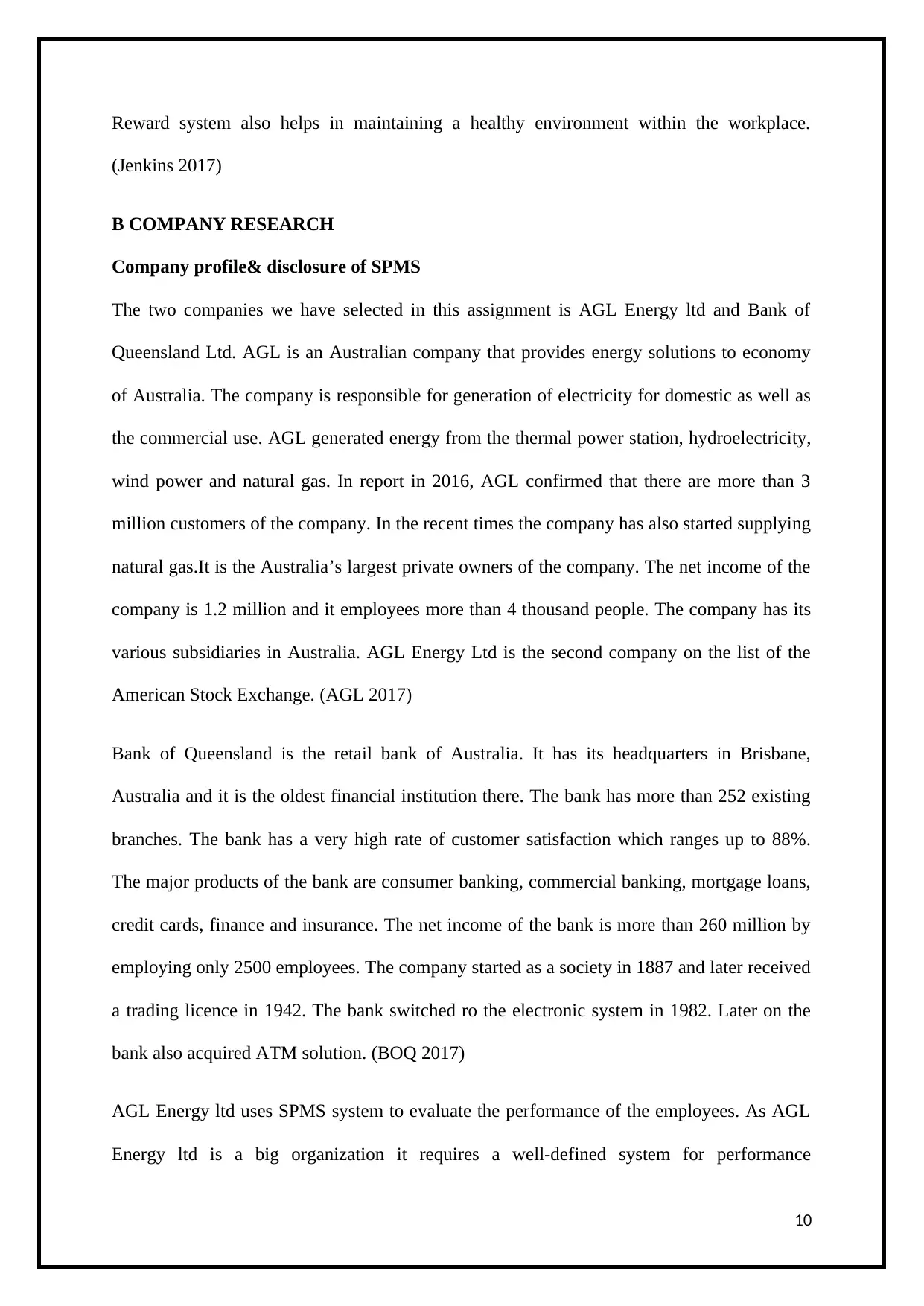
Reward system also helps in maintaining a healthy environment within the workplace.
(Jenkins 2017)
B COMPANY RESEARCH
Company profile& disclosure of SPMS
The two companies we have selected in this assignment is AGL Energy ltd and Bank of
Queensland Ltd. AGL is an Australian company that provides energy solutions to economy
of Australia. The company is responsible for generation of electricity for domestic as well as
the commercial use. AGL generated energy from the thermal power station, hydroelectricity,
wind power and natural gas. In report in 2016, AGL confirmed that there are more than 3
million customers of the company. In the recent times the company has also started supplying
natural gas.It is the Australia’s largest private owners of the company. The net income of the
company is 1.2 million and it employees more than 4 thousand people. The company has its
various subsidiaries in Australia. AGL Energy Ltd is the second company on the list of the
American Stock Exchange. (AGL 2017)
Bank of Queensland is the retail bank of Australia. It has its headquarters in Brisbane,
Australia and it is the oldest financial institution there. The bank has more than 252 existing
branches. The bank has a very high rate of customer satisfaction which ranges up to 88%.
The major products of the bank are consumer banking, commercial banking, mortgage loans,
credit cards, finance and insurance. The net income of the bank is more than 260 million by
employing only 2500 employees. The company started as a society in 1887 and later received
a trading licence in 1942. The bank switched ro the electronic system in 1982. Later on the
bank also acquired ATM solution. (BOQ 2017)
AGL Energy ltd uses SPMS system to evaluate the performance of the employees. As AGL
Energy ltd is a big organization it requires a well-defined system for performance
10
(Jenkins 2017)
B COMPANY RESEARCH
Company profile& disclosure of SPMS
The two companies we have selected in this assignment is AGL Energy ltd and Bank of
Queensland Ltd. AGL is an Australian company that provides energy solutions to economy
of Australia. The company is responsible for generation of electricity for domestic as well as
the commercial use. AGL generated energy from the thermal power station, hydroelectricity,
wind power and natural gas. In report in 2016, AGL confirmed that there are more than 3
million customers of the company. In the recent times the company has also started supplying
natural gas.It is the Australia’s largest private owners of the company. The net income of the
company is 1.2 million and it employees more than 4 thousand people. The company has its
various subsidiaries in Australia. AGL Energy Ltd is the second company on the list of the
American Stock Exchange. (AGL 2017)
Bank of Queensland is the retail bank of Australia. It has its headquarters in Brisbane,
Australia and it is the oldest financial institution there. The bank has more than 252 existing
branches. The bank has a very high rate of customer satisfaction which ranges up to 88%.
The major products of the bank are consumer banking, commercial banking, mortgage loans,
credit cards, finance and insurance. The net income of the bank is more than 260 million by
employing only 2500 employees. The company started as a society in 1887 and later received
a trading licence in 1942. The bank switched ro the electronic system in 1982. Later on the
bank also acquired ATM solution. (BOQ 2017)
AGL Energy ltd uses SPMS system to evaluate the performance of the employees. As AGL
Energy ltd is a big organization it requires a well-defined system for performance
10

management. It requires a very specific and accurate data for the management of its
information. Through the performance management system the company is able to internal
processes as well as accesses the external systems. The company ensures the strategic
maintenance of balance. AGL Energy Ltd also utilizes the balance scorecard method in order
to ensure that top to down performance analysis is made keeping in mind that the employees
are provided with the constructive feedbacks. The performance management by SPMS helps
in maintaining the efficiency within the organization.AGL Energy Ltd. utilizes performance
managementto formulate the strategies and objectives of the company.There has been many
benefits to the company by the adoption of the SPMS such as strong leadership, better
implementation of the strategy and effective communication within the organization. With
the SPMS there has been increased involvement of the staff at all levels of management.
There have been changes in the SPMS system of AGL Energy Ltd with the time. Now the
company has adopted new and effective reward system which will help in motivating the
employees. SPMS also helps in developing the cause and effect relationship within the
organization. With the implementation of the new reward system the employees were given
valuable feedbacks which improved the performance of the employees over the span of time.
As the company has seen significant growth with time there has been a lot of change in
perspective and objectives of SPMS. (Gungor 2011)
Bank of Queens land also uses strategic performance management system to handle their
finances. As the company belongs to the financial system the use of SPMS for handling the
financial data is even more effective. The financial growth of the company could be tracked
easily with the help of this software. Banking is a very vast domain and with the use of the
SPMS bank of Queensland is able to maintain accuracy and transparency in its business
operations. As banking has evolved a lot with time, there has been many changes in the
SPMS systems for the banks. SPMS makes the banks services more effective and efficient.
11
information. Through the performance management system the company is able to internal
processes as well as accesses the external systems. The company ensures the strategic
maintenance of balance. AGL Energy Ltd also utilizes the balance scorecard method in order
to ensure that top to down performance analysis is made keeping in mind that the employees
are provided with the constructive feedbacks. The performance management by SPMS helps
in maintaining the efficiency within the organization.AGL Energy Ltd. utilizes performance
managementto formulate the strategies and objectives of the company.There has been many
benefits to the company by the adoption of the SPMS such as strong leadership, better
implementation of the strategy and effective communication within the organization. With
the SPMS there has been increased involvement of the staff at all levels of management.
There have been changes in the SPMS system of AGL Energy Ltd with the time. Now the
company has adopted new and effective reward system which will help in motivating the
employees. SPMS also helps in developing the cause and effect relationship within the
organization. With the implementation of the new reward system the employees were given
valuable feedbacks which improved the performance of the employees over the span of time.
As the company has seen significant growth with time there has been a lot of change in
perspective and objectives of SPMS. (Gungor 2011)
Bank of Queens land also uses strategic performance management system to handle their
finances. As the company belongs to the financial system the use of SPMS for handling the
financial data is even more effective. The financial growth of the company could be tracked
easily with the help of this software. Banking is a very vast domain and with the use of the
SPMS bank of Queensland is able to maintain accuracy and transparency in its business
operations. As banking has evolved a lot with time, there has been many changes in the
SPMS systems for the banks. SPMS makes the banks services more effective and efficient.
11
⊘ This is a preview!⊘
Do you want full access?
Subscribe today to unlock all pages.

Trusted by 1+ million students worldwide
1 out of 19
Related Documents
Your All-in-One AI-Powered Toolkit for Academic Success.
+13062052269
info@desklib.com
Available 24*7 on WhatsApp / Email
![[object Object]](/_next/static/media/star-bottom.7253800d.svg)
Unlock your academic potential
Copyright © 2020–2025 A2Z Services. All Rights Reserved. Developed and managed by ZUCOL.





